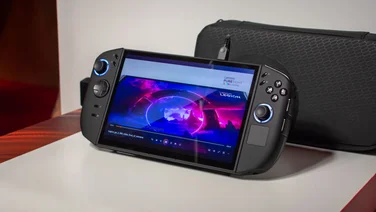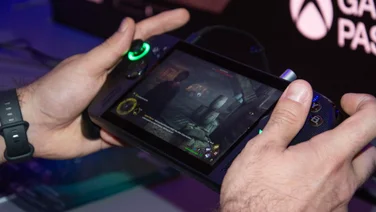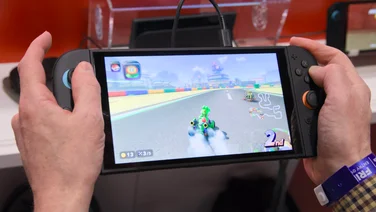To help us provide you with free impartial advice, we may earn a commission if you buy through links on our site. Learn more
- Xbox Series S review: What you need to know
- Xbox Series S review: Price and competition
- Xbox Series S review: Design and key features
- Xbox Series S review: Controller
- Xbox Series S review: Performance and user interface
- Xbox Series S review: Games, Storage and Games Pass
- Xbox Series S review: Verdict






- Fantastic compact design
- Slick and snappy UI
- Ample horsepower for next-gen gaming at 1080p and 1440p
- Lacks 4K gaming support
- Limited storage
The Xbox Series X and PS5 delivered exactly what you’d expect from new console launches: benchmark-shattering performance, advanced graphics capabilities and new gameplay features – and all for a rather stonking price. With the Xbox Series S, however, Microsoft has taken a completely new approach: a lower-powered, cut-back console designed specifically to hit the mass market.
READ NEXT: Xbox Series S/X versus PS5, which is best?
Think of it as a sort of ‘people’s Xbox’, with some inevitable compromises and just a few things that leave us worrying about its long-term future. Yet it’s also a fantastic little games machine that gives cash-strapped gamers (or their parents) a more affordable way into the next generation. To the hardcore gamer – those prepared to spend £450 on a console or just a PC graphics card – it might seem irrelevant, even nonsensical, but for a lot of people it might just be the best console to buy.
Xbox Series S review: What you need to know
The Xbox Series S’ selling point is that you can play the same games as the £450 Series X but on a console less than half the size and almost half the price. This doesn’t just apply to games from the existing library of backwards-compatible Xbox titles, either, but next-gen game launches going forward. Even the most demanding, awesome-looking, benchmark-raising flagship Xbox exclusives will have to run on the Series S as well.
Of course, they’ll have to do so on a device that’s significantly less powerful. The Series S has the same eight-core AMD Zen 2 CPU as the Series X, but it runs at a 200MHz deficit. It also has 10GB of GDDR6 RAM against the Series X’s 16GB. Where the Series X has a 12 teraflop GPU running at 1.825GHz, the Series S has a weedy-sounding 4 teraflop GPU running at just 1.55Ghz. That GPU has just 20 RDNA2 compute units, too, where the Series X GPU has 52.
How on Earth can it play the same games then? Well, where the Series X is designed to play them at native 4K resolutions at 60 to 120fps, the Series S targets a maximum 1440p at 60fps. And in the real world, rather than the world of console specs, that often means 1080p at 60fps or even 1080p at 30fps. If you’re a paid-up member of the benchmark-obsessed PC gaming massive you’ll regard this as the stuff of nightmares, but if games look great and play well at 1080p on Series S, does it really matter?
Xbox Series S review: Price and competition
As we’ve already established, the Series S is a whole lot cheaper than the Series X. It costs much less than Sony’s full-fat, 4K Blu-ray equipped PS5. In fact, its only next-gen competition is the drive-less PS5 Digital Edition, which is identical in specification to the regular PS5, but available for £100 less. At £350, though, it’s still £100 more expensive than the Xbox Series S.
There is, of course, still some current-gen competition. While manufacturing has stopped, you can still buy the old Xbox One S for around £220, while the faster, 4K-capable One X can still be found on eBay for around £250 to £300. PS4 and PS4 Pro consoles are also still available from some outlets for £250 to £300. Most importantly, a Nintendo Switch could be yours for around £280. I wouldn’t suggest buying any of these over a Series S, unless you’re a big Nintendo fan, but the choice is there.
Xbox Series S review: Design and key features
One thing you probably know about the next-gen consoles is that they’re huge. The Xbox Series X is a cuboid monolith that’s too big to fit in almost any AV cabinet. The PS5 is much taller and wider than you think, and might only just squeeze in if you’ve got plenty of spare space. These are effectively gaming PCs using proprietary, integrated components and stuffed into a custom case, and they’re big because they need the airflow.






The Series S is not big. It’s a little white box about the size of a shoebox. In fact, it’s the closest Microsoft or Sony has come to a Nintendo-like design, reminding me a little of the much-maligned Wii-U. There’s a big black grill on the top (or right-hand side if you place it vertically), and otherwise not a whole lot to report. It’s surprisingly quiet when it’s running, too; quieter than the Xbox One X and even quieter than my PS5 Digital, which itself barely makes a whisper.
READ NEXT: The best TVs for next-gen gaming
There’s a single USB 3 port on the front and a further two at the rear, along with a Gigabit Ethernet port, an HDMI 2.1 output and the expansion slot for Seagate’s £220 1TB expansion drive. As with the Xbox One X and Series X, the power supply is – amazingly – internal.
Xbox Series S review: Controller
One thing you’re not getting here is a cut-down controller. It’s Microsoft’s new Xbox Wireless controller as supplied with the Series X, only in what Microsoft calls Robot White rather than Carbon Black. It’s not a huge step up from the old Xbox controller, with the main additions being some new textures on the rear grips and triggers, a different dish-shaped D-pad, and the new share button for capturing video clips and screenshots.
While it doesn’t have the wow factor of the PS5’s DualSense controller and its smarty-pants haptic feedback, it’s still superb. It’s comfortable and responsive with accurate stick tracking and impressive rumble effects.
Xbox Series S review: Performance and user interface
If you’re used to the dashboard UI of the old One S or One X, you’ll find no surprises with the Series S, as it’s now the same across all of Microsoft’s consoles. Where it differs, though, is in the performance. The combination of the faster CPU, high-speed RAM, an SSD and the whole Velocity Architecture makes the Series S feel significantly faster.
I still use a One X as well as a Series S, and the more I use the Series S, the more using the One X feels slow, laggy and a little bit painful. On the Series S, every interaction seems to happen instantaneously, whether it’s booting up from standby, launching a new game or checking the latest deals on the Microsoft Store. On the One X, there’s always a wait, and while it’s sometimes just a second or two, it makes everything feel painfully slow. The Series S feels snappy in a way that Microsoft’s last-gen hero console doesn’t.
The same applies to loading games. In fact, thanks to Xbox Smart Delivery, games tend to take less space on the Series S and load even faster than they do on Series X, since the cheaper console doesn’t need to load all those chunky 4K textures.






The Series X’s Quick Resume feature also carries across to the smaller console. After a few teething troubles in the early weeks, I can now flick from Forza Horizon 4 to Gears of War 5 to The Medium and back again, playing from exactly where I left off and without the game having to reload. The only trouble comes with games that use a live Internet connection, and even here Forza Horizon 4 seems to reconnect after a couple of minutes, without any serious impact on the gameplay while it does so.
The big question, of course, is the performance within games, and having had a few months to work with the Series S I’m more than happy. Naturally, there are compromises: you can forget about 4K gaming and I’ve only seen a few titles that run at 1440p. 1080p is a more realistic target for most, though some will go higher at a frame rate of 30fps. Yet big Xbox Series X/S exclusives or enhanced titles look fantastic on the Series S, and – to my surprise – still look and feel like a step on from games on the One X.
Sure, they’re running at a lower resolution, but the higher frame rates – running at 60fps where the One X version ran at 30fps – more than makes up for the loss. What’s more, the Series S does a great job of upscaling to a 4K TV or monitor and new visual effects like ray tracing are still supported in most cases where the Series X has them, though there are some exceptions in certain titles, such as Devil May Cry 5 Special Edition.






There are some disappointments, with the biggest being that many Xbox One games you’ll play through backwards compatibility will run the old One S code rather than the graphically-enhanced One X code, even though the Series S may be perfectly capable of running it at 1080p or 1440p.
However, with titles like Gears 5, Forza Horizon 4, Destiny 2, The Division 2 and others all now equipped with Series S/X enhanced versions, this is becoming less of a big deal. I’ve got a PS5, so my home is hardly short of next-gen muscle, yet I’ve still been gobsmacked by the visuals in Gears 5, The Medium and Destiny 2. What’s more, having had the shorter load times in Destiny 2 and The Division 2 on Series S, there’s no way I’d go back to playing them on my old One X.
Xbox Series S review: Games, Storage and Games Pass
It’s no secret that Microsoft has struggled to get big exclusives out of the door. Three months since release, there’s still only one game you can exclusively play on Series S or Series X, and The Medium is more an atmospheric chiller than a system-selling banger. That said, you’ve still got some fantastic third-party games to play on Series S, including DIRT 5, Call of Duty: Black Ops – Cold War, Assassin’s Creed: Valhalla and Yakuza: Like a Dragon. And there are plenty more on the way.
READ NEXT: Best external hard drive for Xbox Series S/X
More importantly, Xbox Game Pass is still the best reason to buy a Microsoft console. Getting games as good as Gears 5, Forza Horizon 4 and Destiny 2 (with all expansions) on release day as part of an £8 monthly subscription still feels like the gaming deal of the century, and that’s without counting dozens of other great third-party and indie titles. For £11 a month, Game Pass Ultimate also grants access to the library on both Xbox and PC, with EA Play – EA’s impressive archive of games – also thrown in.






You can enjoy all of this with the Series S, and there’s a real feeling that this is how the console was always intended to be used. After all, with no disc drive, Xbox Game Pass and the Microsoft Store are your only sources of new games. But here there’s just one problem, and it’s the Series S’s biggest: the amount of onboard storage is just tiny.
Where the Series S comes with a 1TB SSD, the Series X has just 512GB. To make this worse, only 364GB is usable when you first boot it up. Even with the reduced size of Series S installs, you’re still looking at anywhere between 40GB and a staggering 120GB per game. With just six games installed on my Series S’s SSD, I only have 30GB remaining. If I want to download something new on Game Pass, something else will likely have to go.
There are workarounds, with the most obvious being to plug in an external HDD or SSD. You’ll be able to run backwards-compatible games directly from it, and while you can’t do the same with native Series S/X games, you can archive them to an external drive while you’re not playing them, then move them back when you want to start again. This sounds like a bit of a fiddle, and it is, but it’s a lot faster than downloading them again.
Your other alternative is to buy Seagate’s 1TB expansion drive. This is great, as it’s fast enough to run Series S/X games directly, but it’s also expensive, and I suspect that most people would be better off spending £450 on the 1TB Series X than £250 plus £220 on the Series S and the extra storage. My one big hope here is that the price will come down in time and make expanding the Series S a little more affordable.
Xbox Series S review: Verdict
If you can get all your gaming in within the constraints of the SSD, the Xbox Series S is a superb little console. It’s ideal for the more casual gamer or for someone with a gaming PC or Playstation as their main, but who fancies a little Xbox Games Pass action on the side.
It’s also cheap enough to hit the mainstream, but powerful enough to make next-gen games look great, albeit at a lower resolution. If you want the best, save up for the PS5 Digital or find the extra cash for the Xbox Series X, but the Series S gives you a great gaming experience with the latest games for less.







